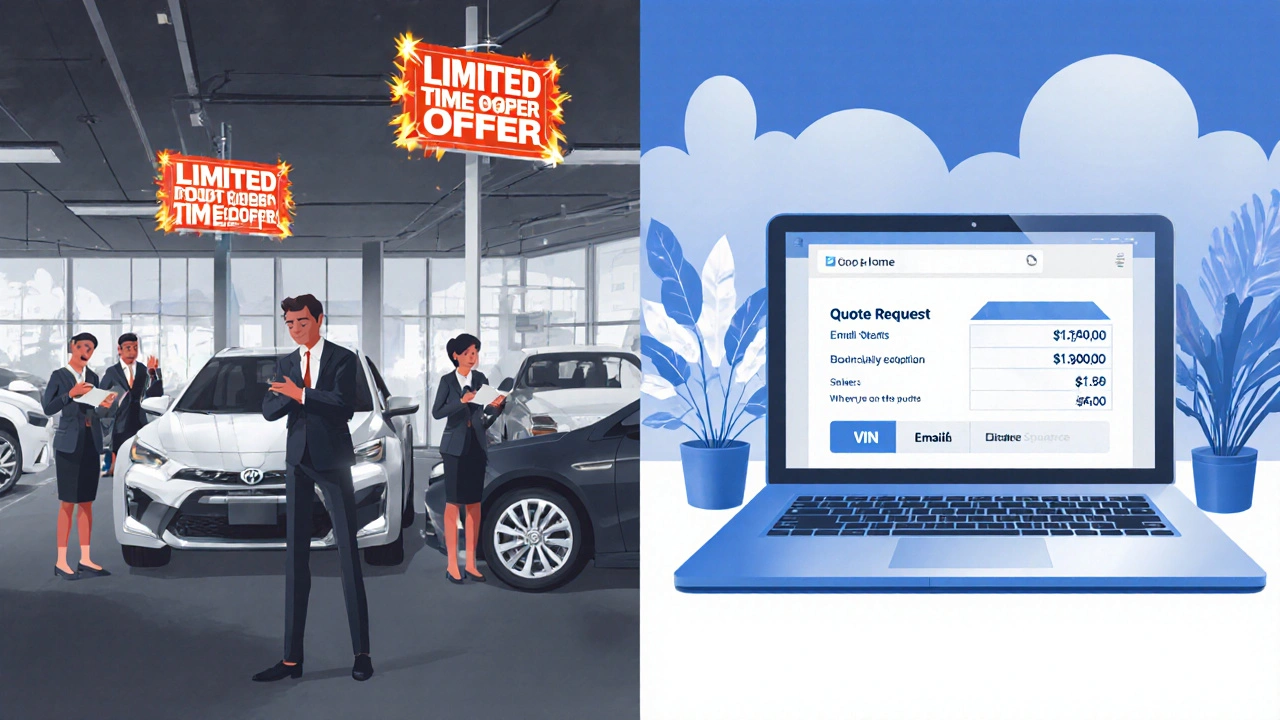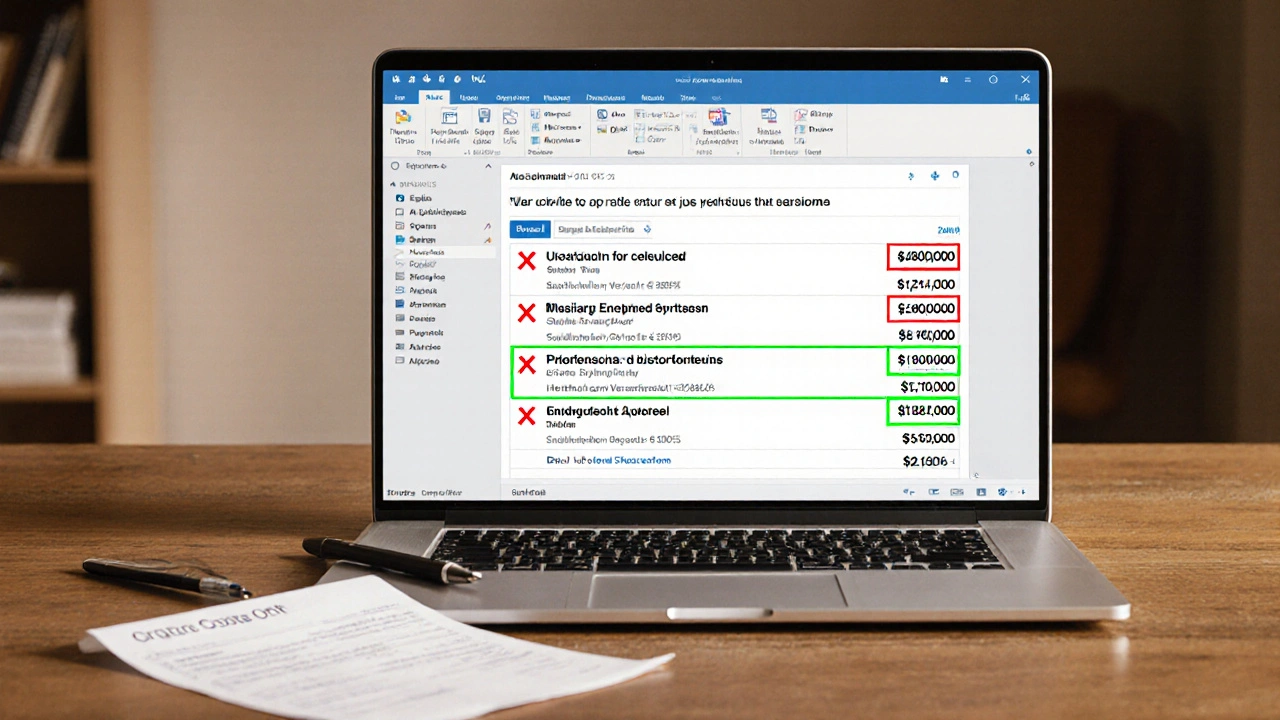Buying a car shouldn’t feel like you’re being played for a fool. Too many people walk into dealerships and end up paying hundreds-or thousands-more than they should. The secret? Skip the pressure tactics. Start with email quotes. It’s not magic. It’s just smart.
Why Email Quotes Work Better Than In-Person Deals
Dealerships make money off urgency. They want you to feel like today’s the only day you can get this deal. That’s why they push you to sign on the spot. But when you use email, you take control. You remove the emotion. You remove the salesperson’s voice in your ear telling you how rare this car is. You’re left with numbers. Just numbers.
A 2024 survey by the UK Consumer Rights Organisation found that buyers who used email to gather at least three quotes saved an average of £1,200 compared to those who negotiated in person. Why? Because email gives you time to compare, to walk away, and to let dealers compete. They don’t like it when you’re not in their showroom. But that’s exactly why it works.
How to Start: Find the Exact Car You Want
You can’t negotiate a price if you don’t know what you’re negotiating for. Be specific. Don’t say, “I want a Toyota Corolla.” Say, “I want a 2023 Toyota Corolla Excel Hybrid, 15,000 miles, silver, with heated seats and parking sensors.”
Use sites like Auto Trader, CarGurus, or PistonHeads to find listings with exact specs. Take screenshots. Copy the VIN. That way, when you email dealers, you’re not asking, “Do you have a Corolla?” You’re asking, “Do you have this exact car? What’s your best price?”
Dealers can’t bluff you if you’ve already nailed down the model, trim, and features. They either match the price-or lose the sale.
Who to Email: Dealerships, Not Just Showrooms
Don’t just email the main dealership. Email every nearby branch. Email online-only dealers. Email independent used car specialists. Even if they’re 20 miles away, they might have the car you want and be desperate to move stock.
Here’s a real example: A buyer in Bristol wanted a 2022 Ford Focus ST-Line. The main dealership quoted £18,995. But a smaller garage in Bath had the same car, same mileage, same options. They quoted £16,750. The Bristol dealer didn’t know about the Bath offer-until the buyer emailed them the quote and asked, “Can you beat this?” They dropped to £16,500.
Don’t assume the closest dealer has the best price. Use Google Maps to find all dealers within a 30-mile radius. Email them all.

What to Write in Your Email: The Template That Works
Here’s the exact email you can copy and paste. Change the details. Keep the tone polite but firm.
Hi [Dealership Name],
I’m looking to buy a [Year] [Make] [Model], [Trim], with [Key Features]. I found one listed on [Website] with VIN [XXXXXX].
Could you please confirm if you have this exact vehicle in stock? If so, what’s your best all-in price including delivery, registration, and warranty? I’m comparing several options and need a firm quote by [Date, e.g., Friday 8th].
Thanks for your help.
Best regards,
[Your Full Name]
[Phone Number]
Why this works: You’re not asking for a ballpark. You’re asking for a firm, all-in price. You’re giving them a deadline. You’re showing you’ve done your homework. And you’re not begging. You’re evaluating.
How to Compare Quotes Like a Pro
Not all quotes are equal. One dealer might say £15,500 but charge £800 for “documentation fees.” Another says £16,200 but includes a full service and 12-month warranty. You need to compare apples to apples.
Create a simple table:
| Dealership | Price | Warranty | Service Included | Extra Fees | Total Cost |
|---|---|---|---|---|---|
| Dealership A | £15,500 | 3 months | No | £750 | £16,250 |
| Dealership B | £16,200 | 12 months | Full service | £0 | £16,200 |
| Dealership C | £15,800 | 6 months | Oil change | £300 | £16,100 |
Now you see it clearly. Dealership B is the best deal-even though the headline price isn’t the lowest. Total cost matters. Warranty matters. Service matters. Don’t just chase the smallest number.
When to Push Back and When to Walk Away
Let’s say you get three quotes. Two are close. One is £1,000 lower. You email the higher ones and say, “I have an offer at £15,800. Can you match it?”
If they say, “We can’t go that low,” ask why. “Is it because of the warranty? The service? Or just because you don’t want to?”
Some dealers will say, “We’re a premium dealer.” Fine. But if their price is still higher than the competition after you’ve added up everything, they’re not premium-they’re just expensive.
Don’t be afraid to say, “I’m going with another dealer.” Most of the time, they’ll come back within 24 hours. One buyer in Bristol got a call at 8 p.m. the night after he said he’d bought elsewhere. The dealer had lowered the price by £1,200.

What Not to Say (and What to Say Instead)
Never say:
- “I only have £16,000 to spend.” (That’s a limit they’ll try to hit, not beat.)
- “I need a car this week.” (Urgency is your enemy.)
- “I love this car.” (Emotion kills negotiation.)
Instead, say:
- “I’m comparing several options.”
- “I’ve got a firm quote from another dealer.”
- “I’m waiting to hear back from a few others.”
You’re not lying. You’re just not giving them leverage.
Final Tip: Always Get It in Writing
Once you’ve agreed on a price, don’t trust a verbal promise. Ask for a written quote via email. Include:
- The exact vehicle (VIN)
- The final all-in price
- What’s included (warranty, service, delivery)
- What’s excluded (optional extras, insurance, finance fees)
- Expiration date
Print it. Save it. Send it to yourself. If they try to add fees later, you point to the email. No debate.
Real Result: How One Buyer Saved £1,800
A woman in Bristol wanted a 2021 Volkswagen Golf GTE. She emailed seven dealers. Four replied. One offered £21,500. Another offered £19,900 with a 12-month warranty. She sent the £19,900 quote to the first dealer and asked if they could match it. They came back at £19,700-£1,800 less than their original offer. She bought it. No haggling. No stress. Just an email chain.
That’s the power of email quotes.
Can I use email quotes for new cars too?
Yes. New car deals often have hidden incentives dealers won’t tell you about unless you ask. Email multiple dealerships with the same model and trim. Ask for their best factory discount, plus any regional promotions. Many will match or beat a competitor’s offer-even for brand-new cars.
What if a dealer says they don’t do email quotes?
That’s a red flag. Most dealerships have sales teams who handle online inquiries. If they refuse, they’re likely hiding a higher price. Move on. There are plenty of dealers who welcome email communication. It’s the norm, not the exception.
Should I mention my trade-in in the email?
No-not yet. Get the price of the car you want first. Once you’ve locked that in, then bring up your trade-in. Dealers often inflate the trade-in value to make the new car price look better. Handle them separately. That way, you know exactly what you’re paying for the car itself.
How long should I wait for a reply?
Give them 24-48 hours. If you haven’t heard back, send a polite follow-up: “Just checking in-did you get a chance to look at my request?” If they still don’t respond, they’re not serious. Move on to the next dealer.
Is it better to email or call?
Email. Calls are for follow-ups, not negotiation. When you call, salespeople will talk you into something. Email keeps the conversation focused on numbers. You can review the quote later, compare it, and respond calmly. That’s how you win.
Using email to negotiate car prices isn’t about being sneaky. It’s about being prepared. You’re not asking for a favour. You’re exercising your right as a consumer to compare, to choose, and to pay a fair price. And with the right approach, you’ll walk away with the car you want-and the savings to prove it.


Comments
Paul Timms
This method actually works. I used it last month and saved over $2k on my Honda Civic.
November 5, 2025 at 08:40
Jane San Miguel
While the premise is sound, the lack of statistical rigor in citing a "2024 survey by the UK Consumer Rights Organisation" without a source or methodology is intellectually lazy. Peer-reviewed data or nothing, please. This isn't a blog post-it's financial decision-making.
November 5, 2025 at 15:53
Kasey Drymalla
DEALERSHIPS ARE TRACKING YOUR EMAILS. THEY KNOW WHEN YOU'RE COMPARING. THEY'RE USING THIS TO PUSH HIGHER PRICES LATER. THEY'RE NOT COMPETING. THEY'RE GATHERING DATA. THIS IS A TRAP. THEY WANT YOU TO THINK YOU'RE WINNING. YOU'RE BEING SCANNED.
November 6, 2025 at 18:56
Bob Buthune
OMG this is literally life-changing 🤯 I emailed 5 dealers and one of them literally cried (I think) when I sent the screenshot of the lower price 😭 I got my car for $14,200 and they threw in free floor mats and a car wash for life?? I didn't even ask for it. I just said "cool, thanks" and left. I feel like a ninja now. My cat is proud. 🐱💼
November 8, 2025 at 03:38
Cait Sporleder
It is worth noting that the efficacy of this strategy is contingent upon a robust competitive marketplace, wherein multiple dealerships possess inventory parity and are incentivized to reduce margins in order to secure sales. Furthermore, the psychological architecture of consumer autonomy-when exercised via asynchronous, text-based communication-disrupts the traditional hegemony of the high-pressure sales environment, which has historically relied upon temporal urgency and affective manipulation to coerce compliance. One might even argue that this method constitutes a quiet revolution in consumer empowerment, particularly within the context of late-stage capitalism's commodification of personal agency.
November 9, 2025 at 07:06
Jeroen Post
You think you're outsmarting them but they're already three steps ahead. Every email you send gets logged into a CRM that tags you as a "price shopper" and bumps your price up by 3% next time. They know you're coming. They know you're comparing. They're waiting for you to blink. The system isn't broken. It's designed to make you feel powerful while it drains your wallet. You're not negotiating. You're performing.
November 11, 2025 at 01:02
Nathaniel Petrovick
bro i did this last week and it was so easy. i sent the same email to 4 places, one replied in 2 hours. i said "can you beat this?" and they did. no yelling, no stress, just a text. i got my truck for $2k under msrp. i didn't even have to leave my couch. best day ever.
November 11, 2025 at 19:21
Honey Jonson
omg yes!! i did this and i was so nervous but it worked!! i misspelled "warranty" in my email and they still gave me the deal lol. i think they felt bad for me?? anyway i got the car and the guy even sent me a meme after. now we're friends. internet is wild.
November 12, 2025 at 23:54
Dave Sumner Smith
They're watching your IP address. They're using facial recognition if you visit the lot. They're selling your email to data brokers who then target you with ads for extended warranties and credit cards. This isn't negotiation. This is surveillance capitalism with a side of sedans. You think you're in control. You're just another data point in their algorithm. They don't care if you save $1800. They just want your name, your phone, your credit score, and your soul.
November 14, 2025 at 22:08